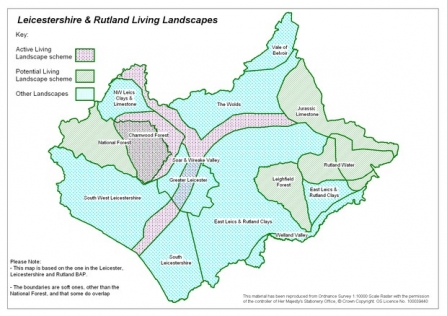Living Landscapes
Our Living Landscapes
We have a vision of restoring, recreating and reconnecting fragmented habitats to create a resilient and healthy environment, cherished, accessible and useful for people and wildlife, teeming with nature and rich in opportunities for learning, health and well-being. These are a mosaic of nature reserves, farmland, amenity land, towns, cities and villages, cared for so that both wildlife and people can flourish.

We have lost so many of our wild lands, and space for nature has sadly diminished. Whilst there are some places, like our nature reserves, where wildlife is flourishing, elsewhere we are losing plants and animals at an alarming rate. These island havens become more and more isolated and wildlife struggles to move between them, separated by agricultural land, buildings, roads and industry.
A Living Landscape removes these barriers, instead finding positive ways of linking up wildlife-rich areas. Wildlife corridors can join the dots and allow wildlife to move more freely and safely, making it more resilient and encouraging populations to grow and thrive. We're creating a number of Living Landscapes across Leicestershire and Rutland, working with stakeholders, landowners, partners and businesses, bringing nature back across the wider landscape and linking up our nature reserves.
Living Landscape Scheme Areas
The Trust works everywhere in Leicestershire and Rutland of course, but we are trying to focus resources particularly in Living Landscape areas to maximise our impact. You can discover more about the areas we're working in here.
Charnwood Forest
The most important area for wildlife in Leicestershire, Charnwood Forest contains a high concentration of Sites of Special Scientific Interest and Local Wildlife Sites. These places have become increasingly isolated by hedge removal, ploughing of grasslands and development. The building of the M1 motorway in the 1950s split the area into two.
The Trust is already a big landowner in Charnwood Forest, managing 800 acres of land as nature reserves. We need to link these together by working with neighbouring landowners and others, promoting government grant schemes, and perhaps even building wildlife bridges over the motorway.
The Charnwood Forest Living Landscape Project, in partnership with Aggregate Industries, aims to conserve and enhance the unique wildlife, geology and character of Charnwood Forest.
Soar and Wreake Valley
We have been doing extensive work to restore wildlife and wild places to the floodplains of the Soar and Wreake - two of the most signficant rivers in Leicestershire - with our goal to enable the floodplain to function naturally, which has huge benefits for nature and for people
We have acquired over 400 acres of land on the Soar floodplain since 2004, offered advice to landowners and carried out extensive habitat restoration work. Since 2008, we have surveyed a large part of the floodplain from Sharnford in the south to Lockington in the north and provided habitat management advice to around thirty landowners. In 2011-12 we surveyed the River Soar through Leicester and its associated green spaces such as Aylestone Meadows. This survey showed that the river corridor is of enormous value for wildlife as it forms a vital link with the river valley to the north and south of the city.
The National Forest
Charnwood Forest and The National Forest overlap, but the latter also includes much of north west Leicestershire. The Trust has been a supportive partner since The National Forest was launched in the early 1990s to create a new wooded landscape across 200 square miles of central England. We have purchased three new nature reserves in The National Forest area and is working with staff at The National Forest Company to improve the area, such as developing better habitat networks.
Leighfield Forest
Straddling the boundary between Leicestershire and Rutland, this former Medieval hunting forest contains numerous ancient woodlands (some managed by the Trust) that have become increasingly isolated from one another through activities such as hedgerow removal. The Trust has successfully lobbied for Forestry Commission funding to assist the creation of new woodlands to link the old ones together, but much more needs to be done.
Rutland Water
This huge man-made reservoir contains Rutland Water Nature Reserve - the Trust’s largest nature reserve. The Trust is already working outside of the reserve to enhance other wildlife habitats, but ultimately we also need to address the river catchment that feeds the reservoir. Activities throughout the whole catchment ultimately affect the water quality of the reservoir, which is important to people and wildlife alike.
Jurassic Limestone
This area covers the Jurassic ‘Oolitic’ limestone of north east Leicestershire and east Rutland - there are other limestones in the two counties. The Trust is working with the Lincolnshire Wildlife Trust and Natural England on limestone grassland conservation in the area, and is aiming to develop a truly holistic Living Landscape scheme that addresses the whole landscape.
